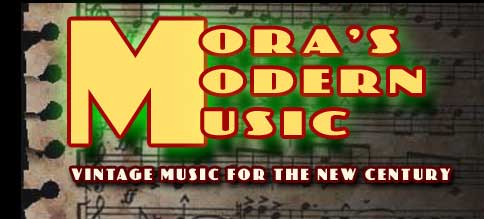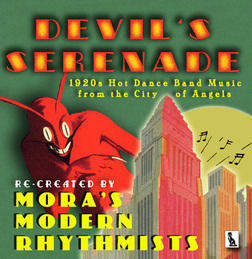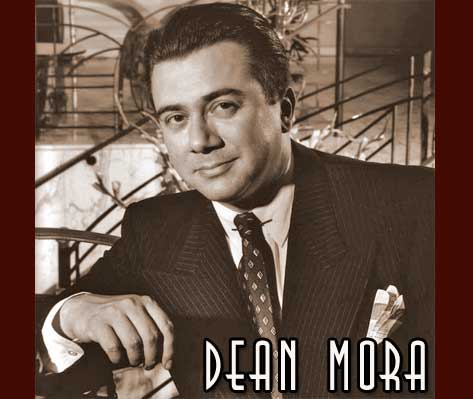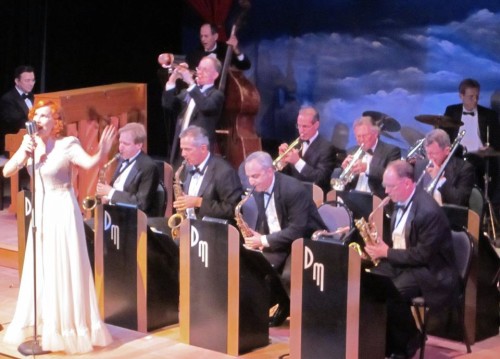~Interview with Dean Mora: 1920’s 1930’s Preservationist Band Leader~
I had the pleasure of interviewing Dean Mora when publishing my magazine Swivel:Vintage Living. I have transcribed and updated this interview to share with a new audience of vintage enthusiasts. He is still one of my favorite working band leaders and is distinctive in his passion for 1929-1936 repertoire. Dean Mora’s Modern Rhythmists was formed in Los Angeles in 1994. They became a favorite with swing dancers in the L.A. area as well as a regular at The Derby. Dean has played piano professionally for years with a degree in performance piano from CSUN. I have been fortunate enough to see him and his wonderful band play and to swing dance the night away with them.
Tammy Francis: What is your favorite place to play and why?
Dean Mora: Naturally I would have to say The Derby; it’s housed in a historical place built in 1929, and the atmosphere is perfet for our type of music. It was the only place in town, back then (1997) that would take us in and allow us to try to build an audience, and believe me, in the early days the club was mighty empty, but they stuck with us.
Tammy Francis: When you’re on stage and look out across the room, what do you see? What would you like to change about that veiw?
Dean Mora: I see dancers really getting into the kind of music we play; it’s different from the usual crop of classic swing tunes they’re used to hearing. It’s particularly good rhythms for Collegiate Shag and Balboa Swing dancers. It’s quite an experience to see people truly enjoy themselves in a nightclub.
Tammy Francis:Do you think we’ll see the return of big ballrooms?
 Dean Mora: In terms of constructing new ballroooms, of course not, but there are many old ballrooms still standing that can enjoy a resurgence in popularity. As hopeful as we can be, you have to accept the reality that, with the fragmented music scene today, none of the large ballrooms could ever sustain themselves in a full-time swing oriented setting.
Dean Mora: In terms of constructing new ballroooms, of course not, but there are many old ballrooms still standing that can enjoy a resurgence in popularity. As hopeful as we can be, you have to accept the reality that, with the fragmented music scene today, none of the large ballrooms could ever sustain themselves in a full-time swing oriented setting.
However, the success of once-a-month venues can demonstrate to other promoters that a similar strategy could be just as popular in another venue, if advertised correctly.
Tammy Francis: How has your focused repertoire hurt or helped you?
Dean Mora: It has certainly set us apart from the other bands, and we’re quickly identifiable among the swing set. However, the general public doesn’t consider our music as “Swing,” but rather chooses those bands who either play in the 1940s/Glenn Miller/String of Pearls style, or the Neo-Swing bands ala Big Bad VooDoo Daddy, Royal Crown Revue, Squirrel Nut Zippers, therefore our popularity is quite limited to hardcore Lindy and Balboa dancers and classic swing aficionados.
We do lose gigs because of our insistence on sticking to our particular repertoire; it can be discouraging, but I’m hoping that soon we can create our own niche.
Tammy Francis: In your bio it reads that you try to resurrect or find obscure songs to play. How important is it to you to produce originals?
Dean Mora: For us, I don’t think it’s necessary at this time. There’s a huge treasure trove of swing tunes waiting for us to resurrect: our library currently consists of almost three hundred tunes, and that’s just barely scratching the surface.
My original goal in forming this group was to revive and present the best in American popular music of this time period, to the public whose memory of these mini-classics have been erased by time.
Throughout the years I have been involved with groups whose purpose was to present historical music: Renaissance ensembles, Civil War bands, ragtime orchestras, but the 1920s and 1930s have always been my favorite era, so I’m right at home here.
We are essentially a repertory band, where our strength lies in performance of classic works, kind of similar to theatre/musical companies or symphonic orchestras, where their appeal is int he expert presentation of existing works. Our group really doesn’t lend itself to writing originals, any attempt to do so may result in writing tunes that may appear as flagrant rip-offs of the original swing tunes.
Now, on the other hand, we may have a better chance if we decided to write originals if for the purpose of having them placed in a motions picture. Bill Elliot Swing Band is a prime example. He’s had many of his original songs places in films and they’re so well-written and arranged, that people have to listen really hard to determine that those are actually new songs. This may be an avenue that I may pursue sometime down the line, but not at this time.
 Tammy Francis: Since we’re both vintage enthusiasts, tell me how you became enamored with vintage cars and clothing.
Tammy Francis: Since we’re both vintage enthusiasts, tell me how you became enamored with vintage cars and clothing.
Dean Mora: I think it all started when I saw “The Sting” in a movie theatre when I was eleven. Although I didn’t quite understand all the plot intricacies at the time, I really fell in love with the clothes and the cars. When one compared them to what we were wearing in 1974, it was quite an eye-opener.
After that I tried to find out all I could about the 1920s and 1930s. My school library happened to have a series “This Fabulous Century,” and I red the entire series twice and tried to emulate the clothing. At the tender age of fifteen the best I could do was a corduroy vest and denim newsboy cap and one of my father’s 1950s ties,(he laughs). Since then I’ve acquired a collection of vintage suits, hats, ties and even my dream car, a 1929 Model A Tudor Sedan.
Tammy Francis: How important do you feel fashion is in reflecting the swing era through dance or music?
Dean Mora: Very important. Popular dancing is a direct reflection of the times and that is true in any era; any dance that was created during a specific time took into consideration the type of clothing people wore. For anyone who wants to achieve the full flavor of swing dancing, they should wear the clothes appropriate to that time period.
Of course, one can take certain liberties with the recommendation, especially when one considers the increasing fragility of aging garments, but there are plenty of reproduction clothing available today.
Tammy Francis:Do you dance?
 Dean Mora: Yes, I do, but I only know the basic steps. I should take some more lessons…
Dean Mora: Yes, I do, but I only know the basic steps. I should take some more lessons…
Tammy Francis: How important do you feel dance is to the music?
Dean Mora:Well, let’s put it this way, every single band that was formed during the Swing Era was started for the purpose of entertaining a dancing audience. You can’t play swing music to seated crowd, they just have to get up and dance.
Tammy Francis: I agree, I cannot go to shows where there’s no dance floor. I’ve even turned down free tickets for lack of dance space.
Dean Mora: I program the bands set list around that persistent question: is this song danceable for the people in the room? Now, not all songs are equally as danceable, some tunes are more suitable for experienced dancers, while others are more accessible to beginners. I gauge the audience at that moment.
Tammy Francis: If you had to pick one major influence for you and your band, who would it be?
Dean Mora: It would have to be Duke Ellington, not only for his genuis, but for the astounding skill of his players: Rex Stewart, Johnny Hodges, Bubber Miley, Cootie Williams, Juan Tizol, etal. They inspire everyone in my band to try to achieve what Duke did with his orchestra.
Tammy Francis: One last question, if you could play anywhere in the world, what would be your dream venue and why?
Dean Mora: If we’re talking dream show, it would have to be the Palomar Ballroom, the “birthplace” of the original swing phenomenon. But it burned down in 1939, so forget about getting booked there.
Of the existing ballrooms then I’d say the Casino Ballroom on Catalina Island. It’s a huge dance floor with a view overlooking Avalon Bay and the structure ans decor has remained basically the same since 1929. (update, since this interview Dean Mora and his Modern Rhythmists have had the distinct honor of playing the historic ballroom).
::
Have you heard Dean Mora play? Have any great stories to tell? Did you see his full band or smaller quintet? What’s your favorite tune they do? Do you recommend any other vintage preservationist bands? Please share! I also use 1920s music and Charleston as a part of my time-travel, murder-mystery, paranormal romance story: The Flapper Affair. Check it out if you like this era!
 Tam Francis is a writer, blogger, swing dance teacher, avid vintage collector, and seamstress. She shares her love of this genre through her novels, blog, and short stories. She enjoys hearing from you, sharing ideas, forging friendships, and exchanging guest blogs. For all the Girl in the Jitterbug Dress news, give-aways, events, and excitement, make sure to join her list and like her FB page! Join my list ~ Facebook page
Tam Francis is a writer, blogger, swing dance teacher, avid vintage collector, and seamstress. She shares her love of this genre through her novels, blog, and short stories. She enjoys hearing from you, sharing ideas, forging friendships, and exchanging guest blogs. For all the Girl in the Jitterbug Dress news, give-aways, events, and excitement, make sure to join her list and like her FB page! Join my list ~ Facebook page

Dismuke. Radio Dismuke. Thats the daily answer to the need…
Thank you for suggesting this site. Looks great. Here’s a link for listeners! http://radiodismuke.com/ LOVE the graphics on the site, too! If y’all like 20s 30s music check this out! Thanks Pas!
Can you post a link of him playing piano?
I will look to see if I can find something. ;)
Great interview, Tammy!
Thanks, He’s an amazing band leader. Check out his CDs!